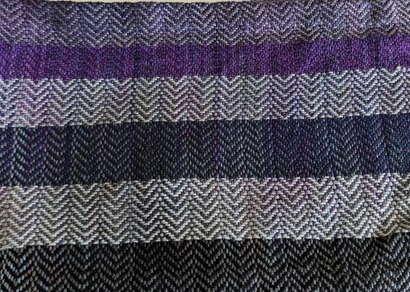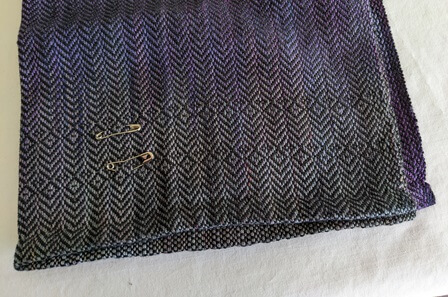Written by Yvonne Ellsworth
I recently published an article “Doubled Up Ice Dyeing” in Handwoven Spring 2024 on ice dyeing two warps at the same time. Then I designed a set of towels with the resulting warp, which became the “Call of the Crows Towels” project in the same issue. Working with Handwoven is always a wonderful experience and I am very proud of my article and project.
Unfortunately, there is never enough room in a magazine to include everything that is learned, and I would like to share some of the things that didn’t make the cut, but I think you might find interesting.
Ice dyeing varies from the dyeing techniques shown in the Dyeing Painted Warps class found here in the Handweaving Academy in a few ways. The warp is first soaked in a soda ash solution. Then ice and dye powder (while wearing a mask!) is used to apply color to the warp. Pure dye colors can be used, but often proprietary blends are preferred because of the way they split into fun color combinations. Urea is not used, because the purpose of Urea is to keep wet things wetter longer. This makes sense when using it to paint a warp, but it isn’t necessary when ice dyeing.
If you want more information on how to ice dye two warps at the same time, you can find detailed instructions in my article “Doubled Up Ice Dyeing” in the Spring 2024 issue of Handwoven Magazine. .
So is ice dyeing better than painting a warp? I would say both have their benefits. There is more control over color placement and design when painting a warp. The results are more predictable and reliable. Ice dyeing is more like free form art. You have an idea of what will happen, but the dye might split a little differently, the ice might melt a little differently, or the temperature of the space might be different. All of these are factors that can change your end result. I recommend experimenting with both types of dyeing to see which appeals to you more.
Once my warp was finished dyeing I needed to pick a draft for the pattern. In my design practice I have found that it’s important to pick the star of the project. So either the yarn can be the star or the pattern can be the star, but it’s much trickier to have both. A painted warp is typically the star of the show. If you have worked to dye one or have purchased a quality one then you really want it to shine, not hide behind a highly intricate draft that might be better suited to a simpler yarn. So, for my towels I picked a basic point twill that was a little more warp dominant, so the warp will show a little more than the weft in the finished piece. The draft I chose was A German Bird’s Eye, Knauer & Stieger-Voelkel No. 7, from The Handweaver’s Pattern Book, by Margeurite P. Davison.
Then once I had the warp on the loom I set to work trying out different weft colors to see what I liked best. I always start with neutral colors of black, white, grey, and brown. I also consider navy blue to be a neutral, because it typically looks good with everything. Think about how jeans go with every color of top and you’ll see what I mean. Then I pick a color pop, in this case a pretty purple.

The white makes me think of soft sandy beaches and the soft brown really speaks to me too, but I ended up choosing the black for my towels because it made me think of crows, which are a favorite of my husband. When I sent the project submission in to Handwoven, I decided to stick with the black, which meant I wove all 4 towels on this warp in black.
However, you have the freedom to do whatever you want with your towels! If you want to weave each one a different color, that’s up to you. If you want to add stripes of varying sizes, that’s entirely your choice. The freedom of being a maker is you get to choose what happens in your project. Tien has many good examples of this in her HA course Designing with Painted Warps.
I will also admit that on the fourth towel I got bored with weaving my point twill pattern over and over, so I reversed it and these adorable diamonds appeared that I love.

I loved them so much that I didn’t take them out and had to tell the Handwoven editors they were there, so they wouldn’t accidentally end up in the photos when I hadn’t written them into the pattern. Oops!
You can do this too. A neat trick is you can upload your draft into handweaving.net and do a search for drafts with the same threading as the one you are working on. It will give you all sorts of different tie-ups and treadlings with your same draft, which you can use to experiment with your towels. So if you weave 1 or 2 and want to try something new, there are so many options. Use a different color or use a different tie up or treadling. So go out, be inspired, and give it a try.

